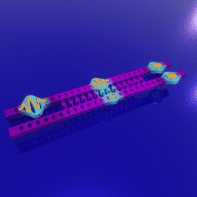Researchers in Japan have made a nanoscale mechanical switch that could ultimately replace semiconductor switches in the electronic devices of the future (K Terabe et al. 2005 Nature 433 47). The device, which works at room temperature, could be used for both logic and fast memory operations.
“Our device can solve all problems that today’s semiconductor devices have,” says Tsuyoshi Hasegawa of the National Institute for Materials Science (NIMS). “By reducing the size of the mechanical device to the atomic scale, it shows much better performance than that of the semiconductor devices.”
Hasegawa and colleagues at NIMS, ICORP-SORST/Japan Science and Technology Agency and RIKEN operated their “quantized conductance” atomic switches by controlling the formation of an atomic bridge between two wires spaced about 1 nanometre apart. One wire was platinum while the other was silver sulphide (Ag2S), which is a solid electrolyte. Applying a positive bias voltage to the silver sulphide caused a silver nano-protrusion to form, creating a bridge between the two wires.
The presence of this bridge boosted the conductance between the wires, putting the switch into its “on” state. Applying a negative voltage, on the other hand, caused the silver bump to shrink, breaking the atomic bridge and switching off the device. The conductance through the device can be as small as one quantum unit of conductance, which suggests that the silver bridge can touch the platinum lead with just one atom.
The team found that the devices worked repeatedly – more than 105 times – and in both air and a vacuum. The switches worked at speeds of 1 megahertz, similar to those of today’s semiconductor devices. The team believes its switches could function at 1 gigahertz, although the capacitance of the wires meant that it was not possible to measure speeds this fast.
“Since an atom is much heavier than an electron, people think that atomic switches should show less performance than electronic devices,” says Hasegawa. “We had to break the common sense by showing the data.” The researchers also made AND, OR and NOT logic gates by combining the switches. “Our device can be used in most electronic products, such as memories and logic circuits for computers,” he said.
By using pulsed bias voltages to tailor the length of the nano-protrusion, the team was able to switch between four of the quantized conductances of each device in a 1 x 2 array. The system worked as an adder circuit, and also as a multi-state memory – it memorized 16 states using just two switches. According to Hasegawa, the researchers are now aiming to use their switches in commercial devices, in conjunction with an electronics company. In the longer term, they plan to work on conceptually new computers.



